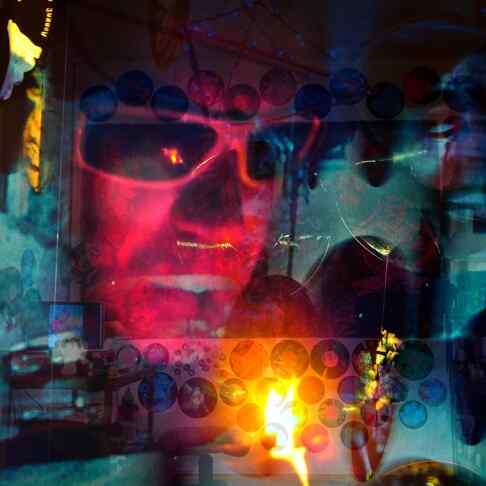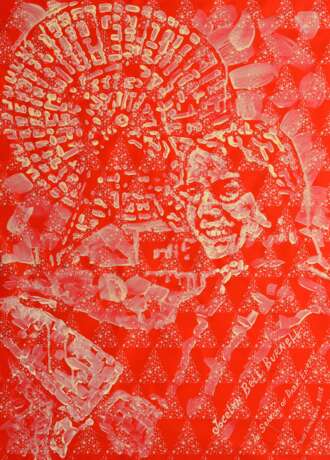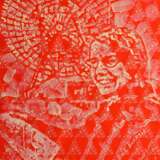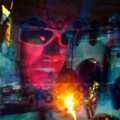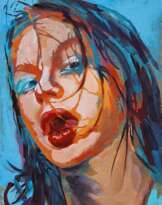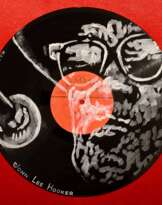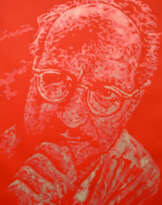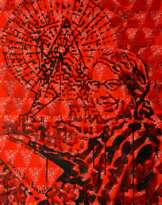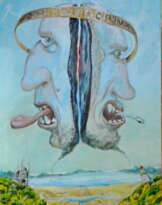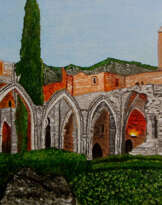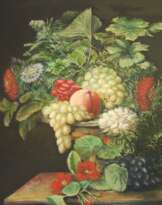JOCELYN BELL BURNELL Acrylic painting Modern art 2016
Yury Ermolenko, "Jocelyn Bell Burnell", ("IN SEARCH OF DARK ENERGY" project), 2016, acrylic on paper, 70х50 cm.
Dame Susan Jocelyn Bell Burnell (born 15 July 1943) is an astrophysicist from Northern Ireland who, as a postgraduate student, co-discovered the first radio pulsars in 1967. She was credited with "one of the most significant scientific achievements of the 20th century". The discovery was recognised by the award of the 1974 Nobel Prize in Physics, but despite the fact that she was the first to observe the pulsars, Bell was excluded from the recipients of the prize.
The paper announcing the discovery of pulsars had five authors. Bell's thesis supervisor Antony Hewish was listed first, Bell second. Hewish was awarded the Nobel Prize, along with the astronomer Martin Ryle. Many prominent astronomers criticised Bell's omission, including Sir Fred Hoyle. In 1977, Bell Burnell played down this controversy, saying, "First, demarcation disputes between supervisor and student are always difficult, probably impossible to resolve. Secondly, it is the supervisor who has the final responsibility for the success or failure of the project. We hear of cases where a supervisor blames his student for a failure, but we know that it is largely the fault of the supervisor. It seems only fair to me that he should benefit from the successes, too. Thirdly, I believe it would demean Nobel Prizes if they were awarded to research students, except in very exceptional cases, and I do not believe this is one of them. Finally, I am not myself upset about it – after all, I am in good company, am I not!." The Royal Swedish Academy of Sciences, in its press release announcing the 1974 Nobel Prize in Physics, cited Ryle and Hewish for their pioneering work in radio-astrophysics, with particular mention of Ryle's work on aperture-synthesis technique, and Hewish's decisive role in the discovery of pulsars. Jocelyn Bell Burnell helped build the Interplanetary Scintillation Array over two years and initially noticed the anomaly, sometimes reviewing as much as 96 feet (29 m) of paper data per night. Bell later claimed that she had to be persistent in reporting the anomaly in the face of scepticism from Hewish, who was initially insistent that it was due to interference and man-made. She spoke of meetings held by Hewish and Ryle to which she was not invited.
Bell served as president of the Royal Astronomical Society from 2002 to 2004, as president of the Institute of Physics from October 2008 until October 2010, and as interim president of the Institute following the death of her successor, Marshall Stoneham, in early 2011.
In 2018, she was awarded the Special Breakthrough Prize in Fundamental Physics, worth three million dollars (£2.3 million), for her discovery of radio pulsars. The Special Prize, in contrast to the regular annual prize, is not restricted to recent discoveries. She donated all of the money "to fund women, under-represented ethnic minority and refugee students to become physics researchers", the funds to be administered by the Institute of Physics.
She graduated from the University of Glasgow with a Bachelor of Science degree in Natural Philosophy (physics), with honours, in 1965 and obtained a PhD degree from the University of Cambridge in 1969. At Cambridge, she attended New Hall, Cambridge, and worked with Hewish and others to construct the Interplanetary Scintillation Array to study quasars, which had recently been discovered.
In July 1967, she detected a bit of "scruff" on her chart-recorder papers that tracked across the sky with the stars. She established that the signal was pulsing with great regularity, at a rate of about one pulse every one and a third seconds. Temporarily dubbed "Little Green Man 1" (LGM-1) the source (now known as PSR B1919+21) was identified after several years as a rapidly rotating neutron star. This was later documented by the BBC Horizon series.
She worked at the University of Southampton between 1968 and 1973, University College London from 1974 to 82 and the Royal Observatory, Edinburgh (1982–91). From 1973 to 1987 she was a tutor, consultant, examiner, and lecturer for the Open University. In 1986, she became the project manager for the James Clerk Maxwell Telescope on Mauna Kea, Hawaii. She was Professor of Physics at the Open University from 1991 to 2001. She was also a visiting professor at Princeton University in the United States and Dean of Science at the University of Bath (2001–04), and President of the Royal Astronomical Society between 2002 and 2004.
Bell Burnell is currently Visiting Professor of Astrophysics at the University of Oxford, and a Fellow of Mansfield College. She was President of the Institute of Physics between 2008 and 2010. In February 2018 she was appointed Chancellor of the University of Dundee. In 2018, Bell Burnell visited Parkes, NSW, to deliver the keynote John Bolton lecture at the CWAS AstroFest event.
Dame Susan Jocelyn Bell Burnell (born 15 July 1943) is an astrophysicist from Northern Ireland who, as a postgraduate student, co-discovered the first radio pulsars in 1967. She was credited with "one of the most significant scientific achievements of the 20th century". The discovery was recognised by the award of the 1974 Nobel Prize in Physics, but despite the fact that she was the first to observe the pulsars, Bell was excluded from the recipients of the prize.
The paper announcing the discovery of pulsars had five authors. Bell's thesis supervisor Antony Hewish was listed first, Bell second. Hewish was awarded the Nobel Prize, along with the astronomer Martin Ryle. Many prominent astronomers criticised Bell's omission, including Sir Fred Hoyle. In 1977, Bell Burnell played down this controversy, saying, "First, demarcation disputes between supervisor and student are always difficult, probably impossible to resolve. Secondly, it is the supervisor who has the final responsibility for the success or failure of the project. We hear of cases where a supervisor blames his student for a failure, but we know that it is largely the fault of the supervisor. It seems only fair to me that he should benefit from the successes, too. Thirdly, I believe it would demean Nobel Prizes if they were awarded to research students, except in very exceptional cases, and I do not believe this is one of them. Finally, I am not myself upset about it – after all, I am in good company, am I not!." The Royal Swedish Academy of Sciences, in its press release announcing the 1974 Nobel Prize in Physics, cited Ryle and Hewish for their pioneering work in radio-astrophysics, with particular mention of Ryle's work on aperture-synthesis technique, and Hewish's decisive role in the discovery of pulsars. Jocelyn Bell Burnell helped build the Interplanetary Scintillation Array over two years and initially noticed the anomaly, sometimes reviewing as much as 96 feet (29 m) of paper data per night. Bell later claimed that she had to be persistent in reporting the anomaly in the face of scepticism from Hewish, who was initially insistent that it was due to interference and man-made. She spoke of meetings held by Hewish and Ryle to which she was not invited.
Bell served as president of the Royal Astronomical Society from 2002 to 2004, as president of the Institute of Physics from October 2008 until October 2010, and as interim president of the Institute following the death of her successor, Marshall Stoneham, in early 2011.
In 2018, she was awarded the Special Breakthrough Prize in Fundamental Physics, worth three million dollars (£2.3 million), for her discovery of radio pulsars. The Special Prize, in contrast to the regular annual prize, is not restricted to recent discoveries. She donated all of the money "to fund women, under-represented ethnic minority and refugee students to become physics researchers", the funds to be administered by the Institute of Physics.
She graduated from the University of Glasgow with a Bachelor of Science degree in Natural Philosophy (physics), with honours, in 1965 and obtained a PhD degree from the University of Cambridge in 1969. At Cambridge, she attended New Hall, Cambridge, and worked with Hewish and others to construct the Interplanetary Scintillation Array to study quasars, which had recently been discovered.
In July 1967, she detected a bit of "scruff" on her chart-recorder papers that tracked across the sky with the stars. She established that the signal was pulsing with great regularity, at a rate of about one pulse every one and a third seconds. Temporarily dubbed "Little Green Man 1" (LGM-1) the source (now known as PSR B1919+21) was identified after several years as a rapidly rotating neutron star. This was later documented by the BBC Horizon series.
She worked at the University of Southampton between 1968 and 1973, University College London from 1974 to 82 and the Royal Observatory, Edinburgh (1982–91). From 1973 to 1987 she was a tutor, consultant, examiner, and lecturer for the Open University. In 1986, she became the project manager for the James Clerk Maxwell Telescope on Mauna Kea, Hawaii. She was Professor of Physics at the Open University from 1991 to 2001. She was also a visiting professor at Princeton University in the United States and Dean of Science at the University of Bath (2001–04), and President of the Royal Astronomical Society between 2002 and 2004.
Bell Burnell is currently Visiting Professor of Astrophysics at the University of Oxford, and a Fellow of Mansfield College. She was President of the Institute of Physics between 2008 and 2010. In February 2018 she was appointed Chancellor of the University of Dundee. In 2018, Bell Burnell visited Parkes, NSW, to deliver the keynote John Bolton lecture at the CWAS AstroFest event.
| ID: | 17246 |
|---|---|
| Artist: | Yurii Yermolenko (b. 1973) |
| Originality: | Original |
| Condition: | new |
| Year of manufacture: | 2016 |
| Applied technique: | See description, Acrylic painting |
| Size: | 50 x 70 x 0.1 cm |
| Framing: | Unframed |
| Art style: | Modern art |
Information about the artist
